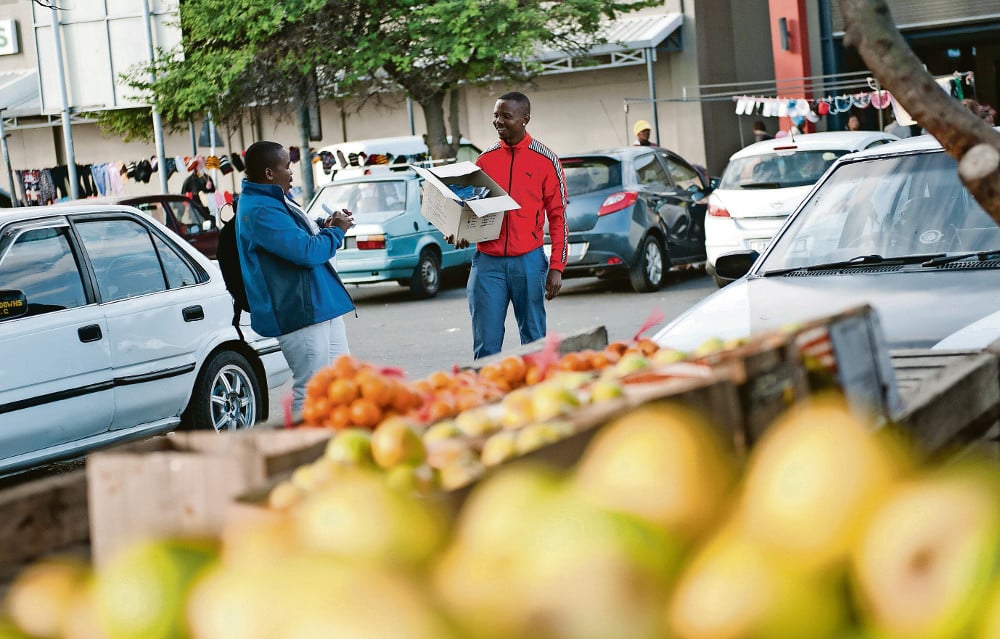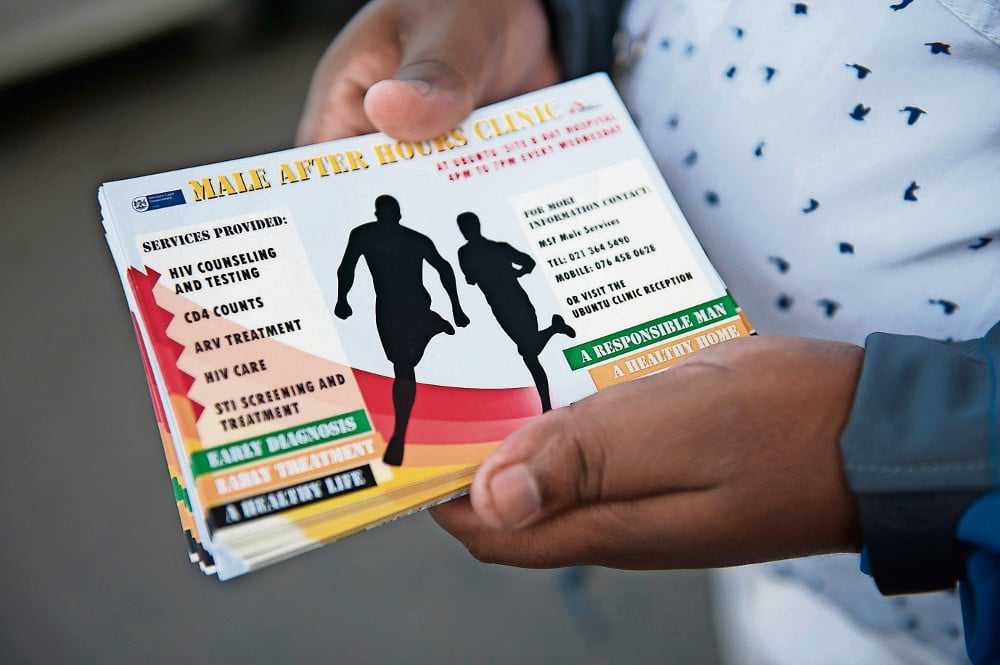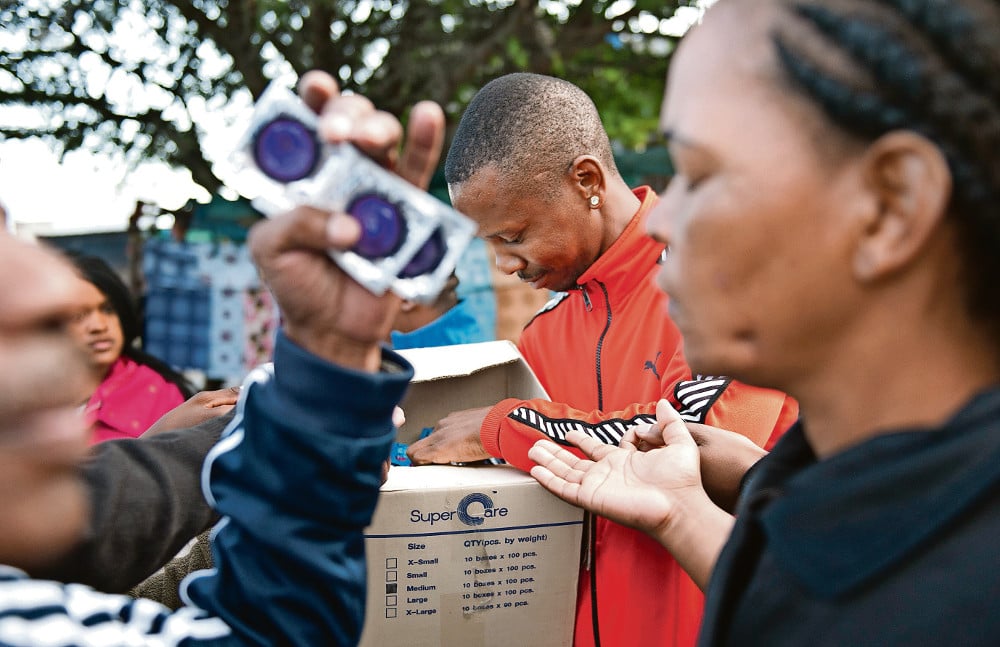A mongrel languishes on the roof of a white car parked on a bustling street in Khayelitsha, a township outside Cape Town. With his head resting on his paws he glances unperturbed at passers-by moving in and out of the busy Nonkqubela Link Mall.
A taxi rank divides them from a maze of dirt roads that, in turn, separate a number of small buildings from each other.
HIV counsellor Thabo Jim leads a patient into one of these structures – a white, box-shaped prefab, the newest clinic in the township.
Inside, a cleaner mops the tiles in the waiting area while a receptionist behind a grey and white counter makes notes. A nurse emerges from a passage on the right and smiles at Jim before they exchange greetings.
What do all these individuals have in common?
They are all men.
And this is an HIV clinic set up specifically for men.
Men only
Site B Men’s Clinic was launched by the City of Cape Town early last year in response to growing evidence that men and women do not benefit equally from the state’s HIV programme.
In South Africa “55% of those living with HIV are women but more than two-thirds of patients receiving public sector ART [antiretroviral treatment] are female”, according to a 2011 study published in the journal Tropical Medicine & International Health, conducted over eight years and involving almost 50 000 patients.
The study also found that, unlike women, men were more likely to start taking ART when the disease was more advanced and, consequently, were more likely to die while receiving treatment than were women.
“We focus on all sorts of vulnerable groups, like the youth and pregnant women, but if we actually look at the data, one of our most vulnerable yet unrecognised groups are the male population,” says Lynne Wilkinson, Médicins Sans Frontières’s (MSF) Khayelitsha-based project co-ordinator.
Overall, South African men also have lower HIV testing rates, she says. “Although this has been raised before it doesn’t seem to be getting the necessary attention; there isn’t any focus on this group in terms of the national HIV programme or from international donors – and we need to ask ourselves why this is the case and what we can do about it.”
Men don’t go to clinics
Although there is significant evidence that men don’t go to clinics for HIV services in the same numbers or as frequently as women, and suffer as a result, there is little in the scientific literature to suggest why.
MSF and the nongovernmental organisation Anova Health conducted a survey among 200 men living in Khayelitsha in 2012 to try to close this research gap.
Most respondents (99%) said they would prefer to attend a male-only clinic even if they had to wait longer. Close to half the men surveyed said they avoided primary health care clinics “because of female staff”.
“It was interesting to find out from the survey that men didn’t necessarily feel discriminated against in the general clinics, they just felt more comfortable with male staff,” says Wilkinson.
Health experts are still trying to understand why this is so and, according to Wilkinson, the only leads they have are anecdotal.
But Jim has a few theories based on his experience in the field.
Masculinity
“There is a belief, especially here in Khayelitsha, that men need to show strength and to go to a clinic when you are not sick is a sign of weakness.”
He says men will often opt to consult a traditional healer many times before being seen going to a health facility.
Cultural beliefs also play a big role, Jim says. “Khayelitsha is dominated by Xhosa people and in our culture, men are very secretive when it comes to health issues – especially sexual health.”
He says that Xhosa men’s experiences at traditional circumcision ceremonies, when adolescents spend time in the “bush” under the guidance of older men, leave them more uncomfortable about sharing sexual and health concerns with women.
“If I go to the clinic and I think I have a sexually transmitted infection and I’m seen by a female nurse I will not feel comfortable showing my private parts to her – it’s my cultural belief,” explains Jim.
Simo Sthandathu, a men’s health mobiliser for MSF in Khayelitsha, agrees: “For us it’s an issue of dignity. We share secrets as men in the bush, and if you show your private parts so easily to a woman, other men will say you have lost your dignity.”
But he does not believe this attitude is confined to Xhosa culture alone.
“It’s broad. It’s the way many men in South Africa are brought up. I remember when I lost my father I struggled because I had to speak to my mother and it was not easy to speak openly to a woman, even though it was my mother: at the end of the day I’m a man,” he says.
There are no such qualms about male health workers.
“If a man goes to the clinic and is seen by a male nurse, the nurse won’t even have to ask him to unzip – he will already have done it because we are comfortable with each other,” says Sthandathu.
Site B Men’s Clinic only employs male staff – the cleaners, clerks, counsellors and nurses are all men.
It is one of three men’s clinics in Khayelitsha but it is the only one where men can be tested and treated. The other two refer HIV-positive men for ART to mixed-gender facilities.
 MSF mobilisers hand out condoms and pamphlets to raise awareness about men’s health
MSF mobilisers hand out condoms and pamphlets to raise awareness about men’s health
Costly service
According to Wilkinson, having a men-only facility is resource intensive and costly. “We’re not sure how replicable this model is for the rest of the country – especially in outlying areas.”
MSF is advocating for a similar men-only strategy but one that uses existing primary health clinics.
Every Wednesday evening from 4pm to 8pm Ubuntu Clinic in Khayelitsha converts from a general HIV facility to a men-only one.
“The normal clinic closes at 4pm so we don’t cut into the services already offered. But the advantage is that we don’t have to set up an entirely new service ourselves – the pharmacy, patient registry and staff are already there,” says Wilkinson.
The male staff are paid by MSF to work extra hours and the clinic sees about 25 men each Wednesday.
“But neither of these services are up to much if we are not mobilising men to attend them,” she says.
More than half of MSF’s work in Khayelitsha is focused on creating awareness about these services and trying to “engage men in dialogue about their health”.
They have partnered with other organisations working in the township, such as the Treatment Action Campaign and Sonke Gender Justice, to launch a number of “male-friendly” awareness initiatives. These include football tournaments, events at taverns and musical entertainment at busy hubs such as taxi ranks and train stations, where they do HIV testing and tell people about the male-oriented facilities.
Awareness
Every week Sthandathu and his team of mobilisers go to a busy Khayelitsha hub armed with a box of condoms and male-services information pamphlets.
They sit outside the Metrorail train station in Site B, warmed by the late-afternoon sun while they wait for the day’s commuters to return home from work.
Every 15 minutes an explosion of people descend the station’s stairs towards the nearby taxi rank, engulfing MSF’s male services mobilisers.
Interested people snatch condoms from the cardboard box while Sthandathu hands out pamphlets to anyone who will take them – a middle-aged woman, a grey-haired man and a group of giggling teenage girls in school uniform.
A toddler, presumably the son of a snack vendor, wanders towards the commotion clutching a packet of Nik Naks. He bends down unsteadily and picks up a stray pamphlet off the floor.
He holds it up towards the crowd of people passing by. A young man with a backpack slung over one shoulder stops for a moment and takes the pamphlet. He glances at it and smiles momentarily before slipping it into his back pocket and continuing with the crowd towards his destination.
Says Sthandathu: “A lot of people ignore us, but at the end of the day we go back to the office with an empty box.”
 Practice: Research in Khayelitsha reveals that men’s aversion to mixed-gender clinics and that this affects their access to ARVs
Practice: Research in Khayelitsha reveals that men’s aversion to mixed-gender clinics and that this affects their access to ARVs
Cape Town’s gender specific centres a no-no for rest of country – department
The City of Cape Town has introduced men-only HIV clinics to try to balance the number of men with the greater number of women being treated but, says the national department of health, it will not be doing the same for the rest of the country.
National deputy director general for maternal health and HIV services Yogan Pillay says the model “is just not going to work” because it is resource-intensive and will exclude other groups who also avoid clinics, such as the youth and sex workers.
The health department’s national strategic plan on HIV, tuberculosis and sexually transmitted infections has set a target that 80% of all eligible people should be on HIV treatment by 2016.
Eligibility depends on CD4 counts, a measure of a person’s immunity and one indication of how far the disease has progressed.
For women, this target of 80% has already been reached, according to Pillay. But only 50% of eligible men are being treated.
Studies show that men, on average, test and start treatment in smaller numbers compared with women. They are also more likely to start taking antiretrovirals later, when the disease is more advanced, and consequently are 31% more at risk of dying.
But Pillay says that men’s clinics, which exclusively employ male staff from cleaners to health workers, are not the answer.
“Do you know how many male nurses we have in the country? Very, very few,” he says.
Instead, he says the department wants to make the current health services more user-friendly and “go to men in their communities instead of waiting for them to come to us”.
This would include conducting testing drives in spaces where men are more likely to congregate, such as shebeens, taxi ranks and in the workplace. The department also plans to extend clinic hours across the board, making it easier for both working men and women to get to these facilities after work.
However, studies show that even if men test positive they are much less likely to start treatment immediately even if their CD4 counts are low.
But Pillay believes this will change once the central chronic medicine distribution and dispensing programme is scaled up. It is currently operational at the National Health Insurance pilot sites. The programme allows stable patients to collect their drugs from pick-up points closer to their homes or work.
He believes these initiatives will result in increasing the number of men on treatment without having to invest in men-only clinics.
“That kind of segregated facility can’t work in the context of a comprehensive health service.” – Amy Green
 Empowerment: Commuters take condoms and pamphlets advertising the men’s clinic distributed by MSF mobilisers
Empowerment: Commuters take condoms and pamphlets advertising the men’s clinic distributed by MSF mobilisers
Masculinity badly affects wellbeing of the wealthy too
South African men fare worse than women when it comes to HIV outcomes.
A 2012 study, published in the Plos Medicine journal, conducted among 46 200 patients taking antiretrovirals between 2002 and 2009 found that men were 31% more at risk of dying while receiving treatment because they often only start taking the medicine once their disease has advanced significantly – when they are already very sick.
But this is a global trend, according to the literature.
Zambian men, after testing positive, were less likely to start treatment than women, according to a 2014 study published in Aids Care.
The authors noted that men’s health “seems to deteriorate” before they access medication “in contrast to women”.
A 2007 study, based in France and published in the International Journal of STD & Aids, found that heterosexual men and migrants were more likely than other groups to test for HIV only once the disease had already progressed to Aids.
Another finding of the South African 2012 study was that the difference in death rates between men and women was even wider in the HIV-negative population.
Across the board, men are more likely to die than women: for example, each year men in the richest fifth of the world are twice as likely to die than women across all age brackets.
These findings were revealed in a 2007 study published in the Journal of Epidemiology and Community Health.
Men’s tendency for “high-risk behaviours” was cited as one possible explanation.
But many studies point to the negative attitudes of men towards health problems, which explains why they are less likely to seek health advice especially for preventative services.
Various reasons have been offered for this behaviour: societal constructions of masculinity have been noted frequently in the literature – underscored by the notion that men should appear strong and that seeking health advice may be seen as a sign of weakness.
The Zambian study authors note that women who don’t go for treatment do so largely because of poverty-related factors.
But men’s reasons were more a result of “social pressure … associated with masculinity”. – Amy Green
